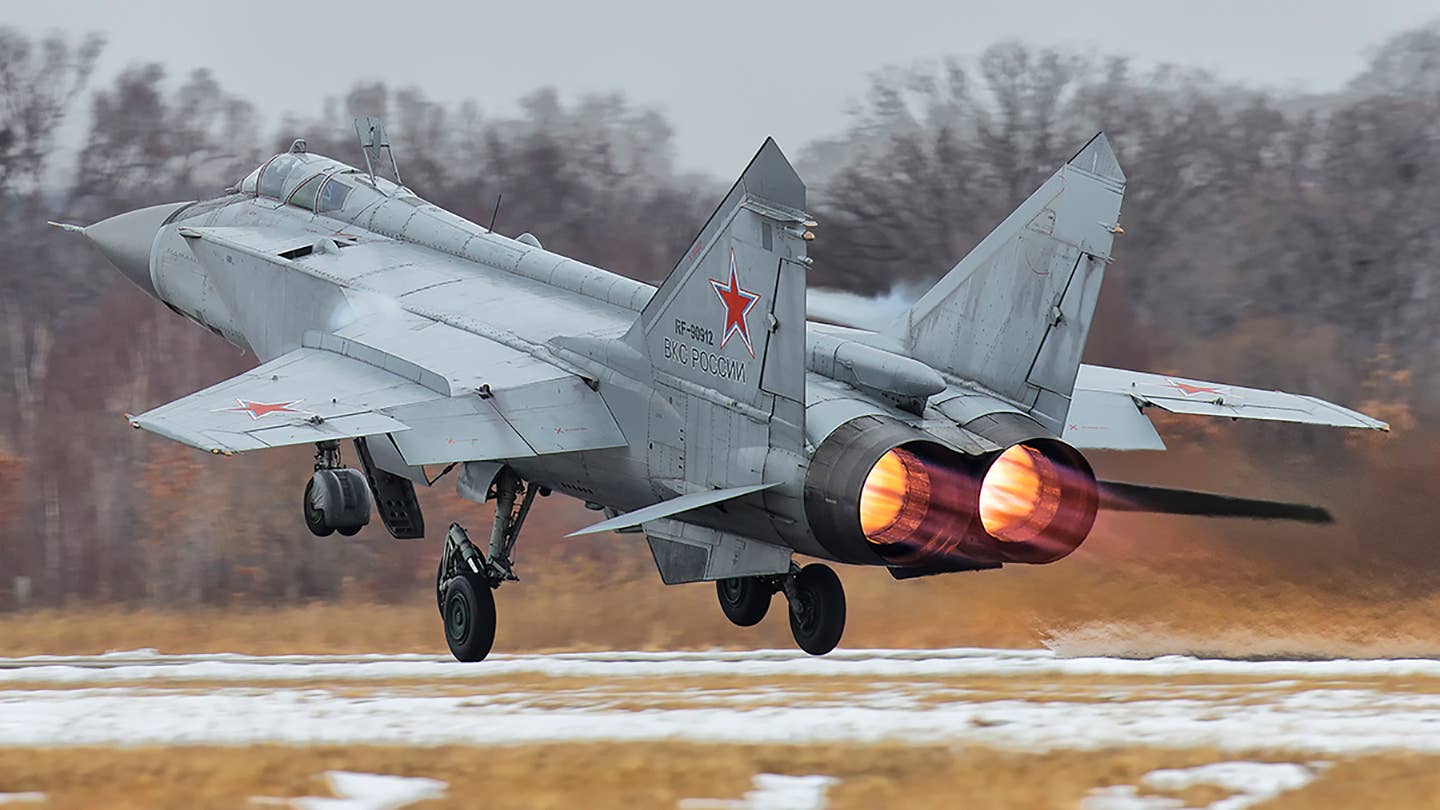The MiG-31 (Western reporting name Foxhound-A) was developed as part of an overall programme to provide the Soviet air defenses with the ability to meet the threat posed by NATO low-level strike aircraft and cruise missiles. It was also intended to fulfill high-altitude and high-speed interception

It was developed as a successor to a MiG-25 interceptor. The prototype Ye-155MP first flew in 1975. Production of the MiG-31 began in 1979 and the type entered service in 1982. A total of 519 of these aircraft were produced. The MiG-31s continue to form the back bone of Russia’s air defenses. At least 300 are in service with Russia, equipping around 15 fighter regiments.
Kazakhstan is the only former Soviet republic to operate the MiG-31, with a regiment based at Semipalatinsk. Some sources report that in 2016 a total of 6 MiG-31 interceptors were delivered to Syria. By 2017 a total of 110 aircraft were reportedly upgraded to MiG-31BM and MiG-31BMS standards in order to extend their operational lives. It is planned that all operational MiG-31s will be upgraded in order to keep them operational.
This interceptor was designed to engage high-flying and high-speed aircraft, such as Lockheed SR-71 reconnaissance planes. The MiG-31 has a high speed, altitude and rate of climb, however it sacrifices maneuverability in order to achieve these capabilities. The MiG-31 is among the fastest production aircraft. It uses missiles to shot-down enemy aircraft at long ranges.

The MiG-31’s Zaslon radar was the world’s first phased-array unit. This radar had a range of 200 km. It could track 10 targets simultaneously, and control the engagement of 4 of them at once. Until 2001 the MiG-31 was the world’s only serial fighter aircraft, equipped with a phased-array radar, when a Japanese Mitsubishi F-2 with an advanced phased-array radar was adopted.
Operational experience showed that the MiG-31 was deficient in range and some 40-45 aircraft were fitted with semi-retractable in-flight refueling probes.
Several MiG-31 variants were proposed for a variety of roles including defense suppression and long-range interdiction.
Variants:
MiG-31M was an advanced version of the MiG-31. It was designed to exploit the longer-range R-37 missiles (with a claimed reach of up to 200 km) as well as the R-77 medium-range air-to-air missiles. It featured Zaslon-M radar, plus a range of new avionics systems, an extensively redesigned rear cockpit with new displays and uprated D-30F-6M engines. The first of seven flying MiG-31M prototypes made its maiden flight in 1985. The MiG-31M had the misfortune of being born at the wrong time, when defense budgets were being slashed. The programme was eventually stopped and the MiG-31M never reached series production.

MiG-31B. Adopted in 1990, the MiG-31B gained the improved Zaslon-M radar. It can track 24 air targets simultaneously and control the engagement of 6 of them at once. The MiG-31B also has better electronic counter measures capability, can carry upgraded R-33S air-to-air missiles and has improved avionics, including new digital processors. All existing MiG-31s were upgraded to this standard. These upgraded aircraft were designated as the MiG-31BS.
MiG-31BS designation of original MiG-31 aircraft, upgraded to the MiG-31B standard. It lacks in-flight refueling capability.
MiG-31E interceptor. It was a proposed export version of the MiG-31B with a downgraded radar.
MiG-31F was a multi-role fighter prototype with an added ground attack capability. It never reached production.
MiG-31FE was a planned export version of the MiG-31F. This designation is also used for a proposed export version of the MiG-31BM.
MiG-31BM is the latest version. It is an improved version of the MiG-31B with an added air-to-ground capability. It was introduced in 1998. The MiG-31BM is billed as a true multi-role aircraft. It is able to undertake long-range interception, precision strike and defense suppression tasks. One of its roles is suppression of enemy air defenses. Both cockpits feature advanced displays allowing the crew to deploy precision-guided munitions.

This aircraft has a further improved Zaslon-AM radar and can detect air targets at a maximum range of 320 km. It can engage 8 air targets simultaneously. Furthermore unlike the earlier versions the MiG-31BM can act as a small airborne early warning aircraft. With to its powerful radar and long detection range it has an added ability to track and datalink numerous radar contacts. The MiG-31BM can also act as an airborne command post and coordinate the actions of other types of fighters that have less powerful radars.
MiG-31BSM is a designation of MiG-31BS aircraft upgraded to the MiG-31BM standard. It lacks in-flight refueling capability. Such upgrade allowed to extend operational life of these aircraft for at least another 15 years.
